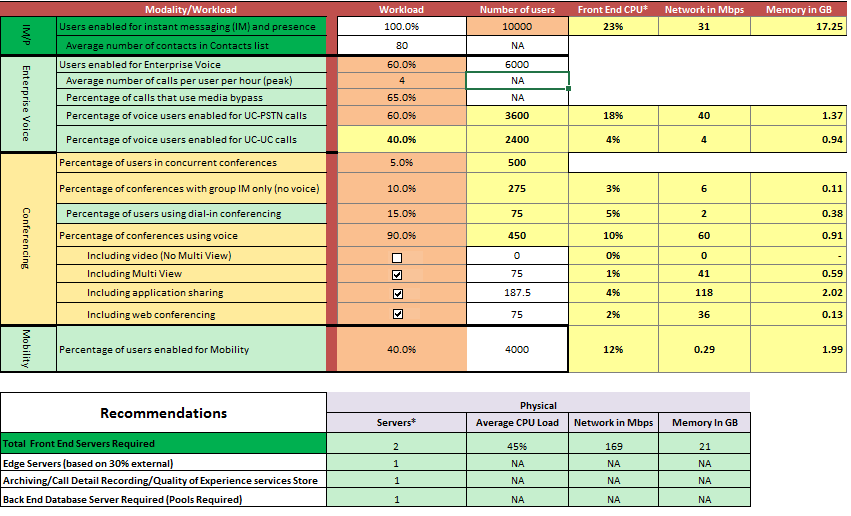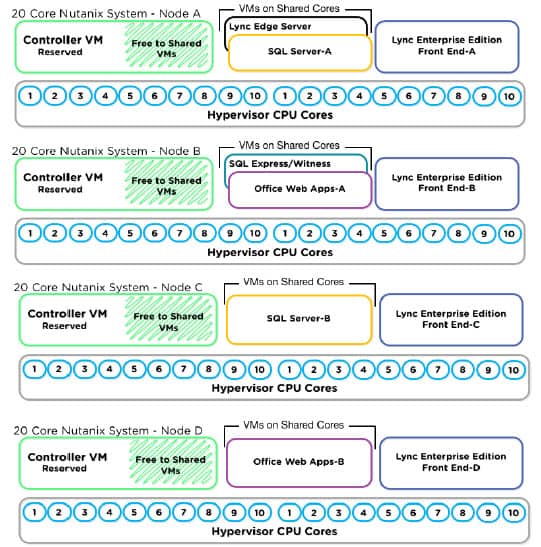In this article I’ll be covering how to size and deploy Microsoft Lync Server 2013 on Nutanix. This article is a subset of a newly released whitepaper which covers SMB (1,000 users), medium (10,000 users), and large (26,664 users) size Lync deployment scenarios. You can download the full whitepaper for free here. In this blog post I’ll just cover the medium sizing scenario and you can check out the whitepaper for SMB and enterprise configurations.
The whitepaper also covers a lot of Hyper-V best practices for virtualizing Lync, so be sure to check it out. I would also like to add that Jason Sloan from Perficient (@Jason_D_Sloan), a Lync Certified Master, played a key role in the content. He has extensive experience with global Lync deployments, so tapping his expertise for this whitepaper was a big win.
When deploying Lync Server 2013, you want a resilient and scalable platform so that as your Lync environment grows, so can your infrastructure. Nutanix delivers a highly resilient converged compute and storage platform that brings the benefits of web-scale infrastructures to all organizations. Designed for supporting virtualized environments including VMware vSphere, Microsoft Hyper-V, and KVM, Nutanix is the ideal infrastructure for running all types of virtual workloads including real time technologies such as Microsoft Lync Server 2013.
Lync 2013 Overview
The core deployment for Lync Server 2013 consists of the “Front End” role which is required for a deployment, commonly referred to as the “Pool”. The Front End service can run on either a Standard Edition Lync Server or the Enterprise Edition Lync Server. The total amount of servers required starts with identifying which edition an organization requires based on business requirements.
In addition to the Lync Server 2013 Front End role, the complete Lync infrastructure is comprised of additional roles. Not all roles however, require their own server as some can be collocated together. Although Lync Server 2013 can be deployed a la carte the following roles are included in the Lync Server 2013 workloads:
- Lync Front End Server – Standard or Enterprise edition
- Lync Director Server – Client authentication
- Lync Edge Server – Remote access
- Microsoft Office Web Apps Server – PowerPoint Sharing and rendering
- Lync Mediation Server – Audio codec transcoding
- Lync Persistent Chat Server – Chat rooms
- Microsoft SQL Server – Database servers
The total number of each of these servers can be extensive depending on the design requirements. There are two key requirements that must be identified that drive the server design and ultimately determine the Lync Server 2013 Edition and total amount servers: user count and high availability. It is important for an organization to understand each server and role they provide. As the environments grow from SMB to large enterprise, the design requirements for the Lync Server architecture begins to scale up. This mirrors the scale up story of the Nutanix platform.
Standard Edition Server – Does not offer high availability, and hosts many services including instant messaging and presence, enterprise voice, archiving, persistent chat, and monitoring.
Enterprise Edition Pool – Comprised of three or more front end servers, they use an external SQL server and it is recommended the SQL server be highly available. Also, persistent chat servers must be deployed separately.
Lync on Nutanix
The Nutanix Virtual Compute Platform is a hyperconverged solution that combines storage and compute resources into a single, integrated appliance. It provides the manageability benefits of centralized storage while delivering high performance by keeping data local to server resources. IT managers can now deliver Unified Communications services with enterprise storage features without the cost and complexity of SAN and NAS systems. The scalability of the Nutanix cluster can accommodate Lync clusters of any size. A Lync deployment on Nutanix is flexible and scalable.
Nutanix delivers a highly available, easy to manage, fault tolerant platform for Lync Server 2013. The fault tolerance and self-healing of the underlying NDFS infrastructure allows critical UC services to be provided to end users without interruption. Nutanix’s ease of installation and setup cuts down UC deployment times by slashing the time needed to configure storage infrastructure. No more Fibre Channel zoning, LUN creation, LUN masking, etc.
Lync Full Capacity Sizing
With Lync Server 2013, server platform system requirements for physical hardware and virtualization are identical which simplifies planning. These Microsoft requirements are based solely on full capacity physical deployments (200K users), which may not apply to your environment. To view workload capacities, see the Microsoft TechNet article for more details. For each Front End, Back End and persistent chat servers Microsoft recommends 12 vCPUs (dual hex-core) at 2.26 GHz or higher with 32GB of RAM. For full capacity Edge, directors and mediation servers they recommend 8 vCPUs and 16GB of RAM. Finally, for Office web apps servers for 200K users, a 16 vCPU VM is recommended. Clearly, for smaller environments the requirements can be scaled back.
Microsoft has developed the Lync Capacity Calculator, which you can download from here. Translating calculator results into hypervisor vCPUs is not exactly straight forward. Unlike the Exchange calculator which is amazing, some estimation for Lync sizing is required. So next up is going through the sizing exercise for a “medium” deployment of 10,000 users.
Microsoft does have some virtualization guidelines for Lync, which you can find here. In there Microsoft clearly states that CPU oversubscription is strictly prohibited for Lync server media workloads. This limits the VM density, as we will see later on in this blog post. Lync is not the only UC application that mandates no CPU oversubscription, Cisco and Avaya do it as well.
10,000 Seat Sizing
In this example we are sizing the core Lync components for 10,000 users, N+1 availability, no persistent chat, and will enable archiving/monitoring. In the graphic below, you can see the assumptions we made using the Lync calculator spreadsheet. Your environment will be different, so make sure you adjust accordingly.
According to the calculator two FE servers are required, not taking into account N+1 availability. Taking that into account, and allowing for planned business growth over the next three years, I decided on a total of four FE servers.
Because this deployment is far under the full deployment model, 12 vCPUs for each FE server is likely overkill. So for this model we will use the Lync calculator estimate of 45% CPU load, and translate that into 6 vCPUs (12 vCPUs * .45). Clearly, depending on the usage of Lync in your environment this may be overkill, or inadequate. Proper POC testing is important, to help gauge sizing and ensure optimum Lync performance.
Now that we have calculated how many FE servers we need, the table below lists the remaining servers that we need to account for. Here we can see 2 edge servers, 3 SQL servers (one is SQL express for witness), and two Office app servers for N+1 availability. This deployment requires a total of 11 VMs.
Nutanix has a variety of platforms, each with a different number of CPU cores. Starting with our Haswell nodes, you can customize the CPUs to tailor the hardware to your needs. So the sizing example below is just one possible VM layout, and it would change depending on the model and processor that you select. Nutanix also has free sizing web app that partners can use to map out VMs to servers and get a full bill of materials.
In this example I selected a NX-3000 series node, with dual 10 CPUs. I also fully reserved 8 vCPUs for the Nutanix CVM, to ensure maximum storage performance. The remaining cores were distributed among the 11 VMs, taking into account the CPU oversubscription prohibition for certain VMs like the FE servers. We also included N+1 availability at the Nutanix block level, so any single node can fail and the hypervisor can restart the VMs on another node with adequate capacity. Click on the graphic below to enlarge it and see the proposed VM layout.
If you used the NX-3000 series it would require five nodes (four with VMs, one free for HA capacity), which can be deployed as two block using a total of 4 RU. Three additional slots are open for future expansion of the Lync environment, or other business critical apps. A minimum of 128GB of RAM is needed in each server. To round out the solution two 10GB top-of-rack switches are needed, for a grand total of 6RU. This is a very dense solution, which is also very power efficient. And yes, no additional rack space is needed for a shared storage solution due to the magic of our distributed file system, NDFS.
Summary
Microsoft Lync Server 2013 can be successfully deployed on the Nutanix platform, delivering high availability and true linear scalability. Traditional SAN/NAS complexity is eliminated while providing a highly resilient storage and compute infrastructure with a small datacenter footprint and full Microsoft support. If you need to dramatically scale your Lync infrastructure, you can easily just add more Nutanix nodes to linearly scale the performance.
Nutanix is the optimal compute and storage platform for critical real-time UC applications, allowing Unified Communications pool scaling as needed during a deployment, instead of building the entire infrastructure up front for only a small number of users. This flexibility makes Nutanix a perfect fit for on premise, private-cloud, or “UC as a Service” deployment models where scale over time is crucial.
By following the guidelines and best practices presented in the Nutanix whitepaper available here, you can successfully design and deploy a Microsoft Lync Server 2013 solution on Nutanix at any scale in a highly reliable manner using the minimum amount of rack space and power.
You can download the full whitepaper here.







